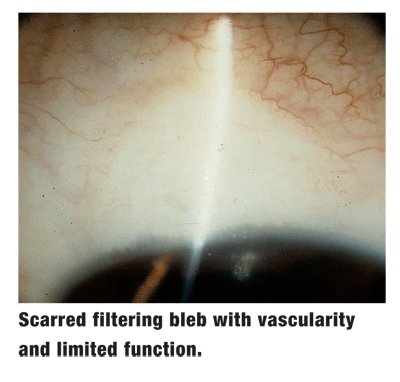 Q: I have a patient who has had a recent trabeculectomy. How do I determine if the bleb is working and what are some possible complications?
Q: I have a patient who has had a recent trabeculectomy. How do I determine if the bleb is working and what are some possible complications?
A: The bleb should have a moist, lobular appearance and the walls of the bleb may contain microcysts, an indicator of aqueous filtration, says optometrist John Insinga, center director of Omni Eye Services, in
Generally, a bleb that is diffuse and ischemic with controlled intraocular pressure (IOP) is a sign of a well-formed filter. Low IOP alone, however, does not guarantee a well-functioning bleb.
A flat bleb accompanied by low IOP may indicate a choroidal effusion or a bleb leak, says Douglas Grayson, M.D., chief of cataract and glaucoma surgery at Omni Eye Services of New Jersey and
Because the surgery changes the aqueous activity of the eye, various post-op complications may occur. Over-filtration may result in hypotony, hypotonous maculopathy, choroidal effusion, choroidal hemorrhage, or a flat anterior chamber, Dr. Insinga says.
Aqueous misdirection, uncontrolled IOP and bleb leaks are some of the other potential complications of filtration surgery. Symptoms of aqueous misdirection are high IOP and a shallow anterior chamber, says Dr. Grayson.
Also, a leaking bleb allows microorganisms to enter the interior of the eye, which could lead to infection. You can convey these symptoms to patients with the acronym RSVP as suggested by Richard Parrish, M.D. among others, says John McSoley, O.D., assistant director of optometric services at the Bascom Palmer Institute in
 Q: What is the latest thinking on the use of valves?
Q: What is the latest thinking on the use of valves?
A: Patients with a high risk for trabeculectomy failure are ideal candidates for drainage device implantation. Glaucoma drainage devices, also referred to as tube shunts, are implanted to maintain an artificial drainage filter.
But not all drainage devices contain valves. The most commonly used glaucoma implants are the Ahmed valve (New World Medical, Inc.) and the Baerveldt implant (Advanced Medical Optics, Inc.).
Postoperatively, IOP may drop, which could cause aqueous flow into the reservoir. The Ahmed prevents the flow with a one-way valve.
The Baerveldt implant serves the same purpose as the Ahmed, but without a valve mechanism. Instead, the implant contains a surgeon-installed releasable ligature system. The ligature temporarily slows aqueous access to the reservoir in order to avoid unrestricted outflow and hypotony in the early postoperative period, says Dr. Insinga.
Patients at high risk for trabeculectomy failureincluding those with neovascular, uveitic, and iridocorneal endothelial syndrome glaucomasare excellent implant candidates, says Dr. Grayson. Patients who have fibrotic, non-viable conjunctivae due to previous surgical intervention may also be better managed with a glaucoma implant.
Potential complications following glaucoma drainage device implantation vary. They include infection, hypotony, device failure and serous or hemorrhagic choroidal detachments.
During the post-op period, timely detection of any complication and prompt communication with your patients surgeon is key. The patient should be seen by an O.D. every three months for regular glaucoma management. Patients who experience changes in IOP or any of the RSVP symptoms should be seen immediately.

